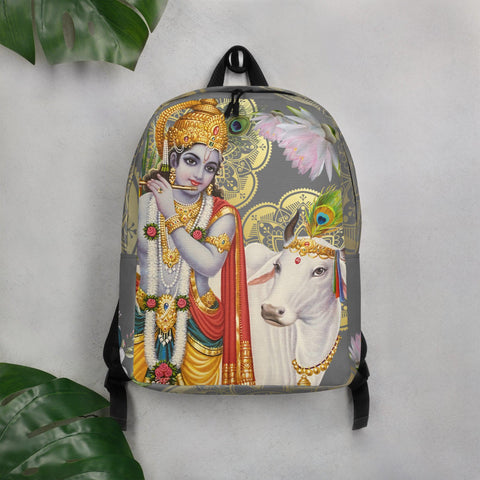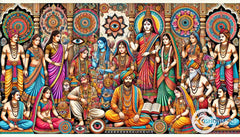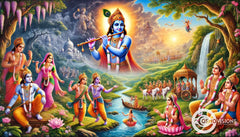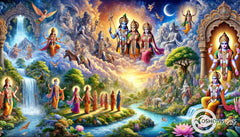Exploring the Divine Differences Between Lord Shiva and Lord Krishna in Hinduism
Posted by Massimiliano Geraci
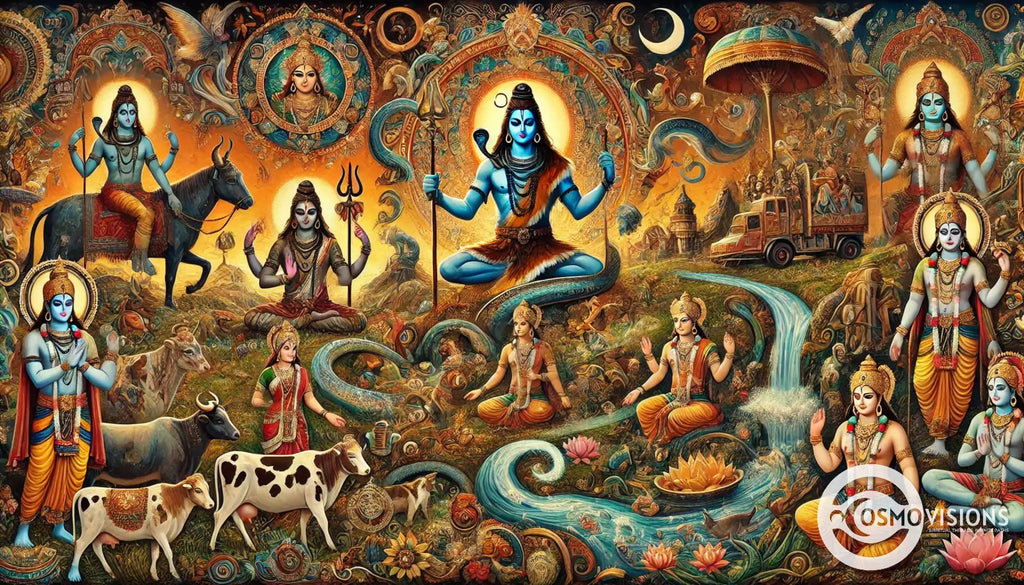
Many people find themselves puzzled by the rich tapestry of deities in Hinduism, especially when trying to understand the distinctive roles and teachings of Lord Shiva and Lord Krishna.
The Hare Krishna movement provides valuable insights into the relationship between Lord Krishna and Lord Shiva, emphasizing the importance of understanding their teachings and principles.
Krishna vs Shiva: Both are central figures, yet they embody different aspects of the divine that appeal uniquely to their devotees. A common query arises: how do these two powerful entities differ, and what lessons can we learn from their stories?
Interestingly, one fact that stands out is both Shiva and Krishna are considered manifestations of the Supreme Personality of Godhead in various scriptures within Sanātana Dharma (Hinduism), each playing a unique role in the cosmic dance of creation, preservation, and destruction.
This blog aims to shed light on their divine differences through exploring their iconography, teachings, worship practices, philosophies, and tales – all designed to provide a clearer understanding for enthusiasts immersed in spirituality and Indian art.
Discover the profound wisdom embedded in their narratives. Get ready for an enlightening journey!
Who are Lord Shiva and Lord Krishna in Hinduism?
Lord Shiva, often referred to as Mahadeva, holds a paramount position in Hinduism, symbolizing the principles of destruction and regeneration. His role transcends mere annihilation, implying transformation and renewal essential for sustaining the universe’s cyclic order.
Devotees of Shiva engage deeply in worship practices that honor his essence as the supreme being who dances the cosmos into existence or dissolves it into nothingness. Drawing from texts like the Shiva Purana, followers seek to understand his complex nature through rituals and meditation, striving to embody his characteristics of detachment and asceticism.
In Hindu theology, Lord Shiva's position is often compared to that of Lord Acyuta (Vishnu). While some consider Shiva supreme, scriptures like the Bhagavata Purana highlight that Vishnu is the ultimate Godhead to whom Shiva must bow down. This theological perspective portrays Shiva as both God and different from the Godhead, with the worship of Vishnu being considered the ultimate path to liberation according to various Sampradayas.
Sri Krishna represents an entirely different spectrum of divinity within Hinduism; as a pivotal avatar of Lord Vishnu, he embodies love, compassion, and dharma (cosmic law). Narratives about Krishna’s life—ranging from his playful childhood pastimes to profound philosophical discourses in texts such as the Bhagavad Gita—resonate deeply with devotees.
As Sri Krishna himself states in one god these dialogues, he assumes human form whenever dharma is at risk in the world. Devotees find solace and guidance in serving Sri Krishna through bhakti yoga (the path of devotion), celebrating festivals like Janmashtami with fervor while contemplating teachings that emphasize duty without attachment to results.

Understanding Lord Shiva's Role in Hinduism
Shiva holds a central role in Hindu tradition, embodying the qualities of a destroyer and restorer within the Trimurti alongside the gods Lord Brahma the creator and Vishnu the preserver. His devotees, known as Shaivites, see Shiva not just as the lord of destruction but also as a symbol of mercy, benevolence, and guardian against evil.
Through his dance, the Tandava, he both destroys ignorance and ushers the world in enlightenment, illustrating the cyclical nature of creation, preservation, and dissolution material energy in the universe.
Worshipers often approach Shiva through rigorous penance or meditation to seek his blessings for liberation from illusion (Maya) and cycles of birth and death. They chant mantras such as "Om Namah Shivaya" to honor him while engaging in rituals that stress dispassion (vairagya) and penance and renunciation (sannyasa).
The presence of symbols like lingam serves not just religious ritualistic purposes but also represents Shiva's all-encompassing nature—his formlessness that signifies boundless potential.
In this complexity lies Shiva’s teaching: understanding one's soul by transcending earthly desires to realize Brahman—the ultimate reality beyond duality.
Who is Lord Krishna and His Significance?
Lord Krishna holds a paramount position in Hinduism, celebrated as the universe and supreme lord by devotees and viewed as an epitome of divine love and dharma. His narrative, deeply embedded within the Indian spiritual and cultural fabric, unfolds in ancient texts like the Bhagavad Gita and the Puranas where he imparts wisdom that continues to influence millions worldwide.
As Svayam Bhagavan or the absolute incarnation of Vishnu, Krishna’s teachings offer profound insights into duty, righteousness, and devotion. Embracing his role with grace, Lord Krishna’s life stories embody compassion, valor, and wisdom, making him a central figure in devotional practices.
Srila Prabhupada, the ISKCON Founder-Acarya, has significantly contributed to spreading the teachings of Lord Krishna through his authoritative translations and commentaries on the Bhagavad Gita and Srimad-Bhagavatam. His works guide individuals in understanding their relationship with Krishna and emphasize the importance of reading his versions of Vedic texts for truthful information.
Devotees engage with Krishna on multiple levels; his enchanting flute melodies symbolize universal love while his dialogues and fierce battle with Arjuna on the battlefield serve as a guide for ethical living and spiritual growth.
Through festival celebrations such as Janmashtami and through daily rituals invoking his presence among us—chanting Hare Krishna mantra—followers seek to connect with his divine energy.
This connection is not just about offering worship but also about embracing Krishna consciousness which advocates a lifestyle of selfless action aligned with divine will. Love for Krishna flourishes in hearts worldwide transcending boundaries due to this universal message of love aiding seekers on their journey toward enlightenment.
The Relationship Between Lord Shiva and Lord Krishna
Shiva and Krishna’s relationship encapsulates a profound aspect of Hindu theology, highlighting an enigmatic blend of devotion and divine play. Shiva, revered as the supreme deity in Shaivism, embodies destruction and rejuvenation, aspects vital for maintaining the cosmic balance.
Krishna, on the other hand, represents love, compassion, and dharma as a pivotal figure in Vaishnavism. Despite their distinct roles within the pantheon, texts like the Bhagavad Gita and Puranas describe moments where Shiva becomes a great devotee of Krishna. This act underlines a fundamental belief in Hinduism: all gods are interconnected, displaying unity amidst diversity.
There is also an incident where Maha Vishnu performs Sahasraarchanaabhisheka by chanting 1,000 names of Mahadeva, offering a lotus flower for each name. To test Maha Vishnu, Mahadeva hides one flower. In response, Maha Vishnu plucks out his own eye and offers it as the final flower to Mahadeva.
Lord Shiva's position in relation vishnu and to Krishna is particularly significant. While Shiva is considered supreme by some, scriptures often depict him as ultimately bowing down to Vishnu, who is identified as the ultimate Godhead. This theological perspective portrays Shiva as both God and different from God, emphasizing that worship of Vishnu, or Krishna, is the ultimate path to liberation according to various Sampradayas. Lord Rama, regarded as an incarnation of the Supreme Lord Krishna (Vishnu), worshipped Lord Siva.
Their interactions extend beyond simple narratives; they reveal layers of spiritual teachings. For instance, Lord Shiva meditating upon Krishna exemplifies the seeker’s journey towards understanding higher truths through devotion (bhakti) to Narayana is deemed supreme).
Stories such as Banasura’s defeat shed light on how these divine figures cooperate across celestial realms to uphold moral order. Such tales enrich devotees’ understanding and inspire them to pursue righteousness with fervor akin to that of deities themselves.
Exploring how these relationships influence worship practices offers further insight into their enduring legacy among followers.
How do Devotees Worship Lord Shiva and Lord Krishna?
Devotees worship Lord Shiva by participating in rituals and practices that honor his role as the destroyer of evil and bringer of transformation. They frequently visit temples dedicated to Shiva, offering water, milk, and bael leaves to the lingam, a symbol revered for representing him.
Celebrations during Maha Shivratri embody devotion through fasting, chanting "Om Namah Shivaya," and meditating to connect with Shiva's omnipresent consciousness. The atmosphere fills with fervor as devotees immerse themselves in worship, seeking blessings for purification and spiritual growth.
Worshiping Lord Krishna involves heartfelt expressions of love and adoration towards this incarnation of Vishnu. Devotees engage in singing bhajans and kirtans, reciting the sacred Hare Krishna mantra as a form of meditation to draw closer to Krishna's divine love.
Festivities like Janmashtami highlight these devotional services by reenacting events from Krishna’s life on Earth, such as his playful acts or his teachings in the Bhagavad Gita.
Offering food items especially made for him denotes a personal connection followers strive for, transforming daily rituals into intimate moments with the supreme lord Krishna.
Krishna says surrender unto me; devotees live this teaching through every act of worship.
Worship Rituals and Practices for Lord Shiva
Worshipping Lord Shiva embodies a spiritual journey that transcends mere rituals, inviting devotees into a world of profound reverence and mystical communion. The practices dedicated to Shiva are deeply symbolic, representing the cycle of creation, preservation, and dissolution.
1. Devotees of Shiva often start their worship by visiting temples dedicated to Him early in the morning, especially on Mondays which are considered auspicious for Shiva worship.
2. They perform Abhishekam, a ritual where water, milk, honey, and other sacred substances are poured over the lingam, a symbol of Lord Shiva.
3. Offerings of Bilva leaves are made to the Shivalinga since these leaves hold immense significance in Shiva's worship due to their trifoliate shape symbolizing His three eyes.
4. Followers chant the sacred mantra "Om Namah Shivaya" as an act of devotion, which is said to have cleansing effects on the heart and soul.
5. Many followers observe fasts during Maha Shivratri, a night dedicated to honoring Lord Shiva, staying awake through the night in meditation and prayer.
6. Wearing Rudraksha beads is another common practice among devotees; these seeds represent Shiva’s tears and are worn for spiritual upliftment and protection.
7. Followers often carry out Panchakshara stotra recitations - verses that extol Shiva with five holy syllables forming His name.
8. Circumambulating the lingam or Nandi bull statue is performed while offering prayers; this act signifies the belief in moving from darkness to light under Lord Shiva's guidance.
9. Rituals and meditative practices also focus on inner reflection and personal growth, enhancing one's spiritual journey.
10. These practices aim to bring devotees closer to the Shiva Tattva, fostering a sense of peace and fulfillment. Whether an ardent devotee or an ordinary living entity, engaging in these rituals helps individuals connect with the divine essence of Lord Shiva.
Transitioning from individual practices to communal celebrations brings us to exploring how festivals dedicated to both deities living beings and material nature unite communities in shared acts of devotion.

Devotional Services for Serving Sri Krishna
Devotional service for serving Lord Krishna involve a variety of rituals and practices that embody love and devotion. They enable devotees to establish a personal connection with the supreme lord Krishna, celebrating his teachings and presence. Srila Prabhupada's authoritative teachings from the Bhagavad-gita and Srimad-Bhagavatam have significantly influenced these practices, guiding individuals in understanding their relationship with Krishna.
1. Chanting the Hare Krishna Maha-mantra is a fundamental practice among devotees. This mantra, “Hare Krishna Hare Krishna, Krishna Krishna Hare Hare / Hare Rama Hare Rama, Rama Rama Hare Hare,” is said to be the easiest way to connect with Lord Krishna in this age of Kali.
2. Reading sacred texts, particularly the Bhagavad Gita and Srimad Bhagavatam, allows followers to explore the wisdom shared by Lord Krishna. These texts are considered direct conversations with God, offering guidance on living a life aligned with dharma (righteousness).
3. Participating in kirtans or devotional songs involves both singing and listening to hymns glorifying Lord Krishna. Kirtans are often accompanied by musical instruments like mridangas (drums) and kartals (cymbals), creating an immersive experience of devotion.
4. Engaging in deity worship entails offering food, flowers, and incense to statues or images of Lord Krishna within temples or home altars. This practice helps devotees express their gratitude and serves as a reminder of God’s omnipresence.
5. Observing fasts on Ekadashi (the eleventh day of each lunar fortnight) is believed to bring one closer to Lord Krishna by purifying the body and mind, thus making it easier for spiritual practices.
6. Offering service or seva at temples dedicated to Lord Krishna includes cleaning deities’ abodes, cooking for deities, or helping organize religious events. Such acts are expressions of bhakti (devotion) that deepen one’s relationship with God.
7. Celebrating Janmashtami, the birth anniversary of Lord Krishna, involves elaborate rituals including midnight Aarti (prayer), dramatizing episodes from Krishna’s life known as Leelas, and distributing prasadam (sanctified food).
8. Engaging in Dhyana or meditation focusing on aspects of Lord Krishna’s life encourages followers to internalize his virtues like compassion and love towards all beings.
9. Immunization from material attachments comes through practicing detachment as taught by Lord Krishna in Bhagavad Gita emphasizing simplicity and contentment in life’s journey.
10. Participating actively in community gatherings at ISKCON centers worldwide fosters a sense of belonging among devotees while spreading Krishna’s message of unconditional love and unity.
By incorporating these practices into their lives, devotees foster a deep spiritual connection with the supreme Lord Krishna, cultivating qualities that mirror His divine nature.
Festivals Dedicated to Shiva and Krishna
Transitioning from the personal devotion practiced in services for serving Krishna, we explore the vibrant and communal celebrations that mark festivals dedicated to Shiva and Krishna. These festivals highlight the rich tapestry of worship and bring devotees together in a shared expression of faith and adoration for the divine.
1. Maha Shivaratri: Celebrated in honor of Lord Shiva, Maha Shivaratri falls on the lunar month of Phalguna, which typically corresponds to February or March. Devotees observe fasts, chant mantras, offer special prayers, and perform ritualistic worship (puja) to honor Shiva as the supreme god. This night marks the remembrance of "Shiva's dance," symbolizing creation, preservation, and destruction.
2. Janmashtami: Marking the birth of Lord Krishna, Janmashtami occurs on the eighth day (Ashtami) of the Krishna Paksha (dark fortnight) in the month of Shravana or Bhadrapada (August–September). Devotees celebrate by fasting until midnight, singing devotional songs (bhajans), reciting verses from Bhagavad Gita, and enacting scenes from Krishna's early life. Temples echo with chants while homes are decorated elaborately.
3. Rath Yatra: Although primarily associated with Lord Jagannath (a form of Vishnu/Krishna), Rath Yatra also sees veneration towards Subhadra and Balabhadra alongside depictions connecting with Lord Krishna’s narratives. Held annually at Puri in Odisha, this festival involves grand processions where deities are placed on huge chariots (rathas) pulled by thousands of devotees through the streets, embodying unity among followers.
4. Shivaratri: Not to be confused with Maha Shivaratri, monthly observances called Shivaratri occur on the 13th night/14th day in every lunar month. During these days, devotees perform rituals similar to those during Maha Shivaratri but on a smaller scale – offering prayers to lingams representing Shaiva Puranas' sacred symbolisms.
5. Gopastami: Celebrating Lord Krishna's pastoral life as a cowherd boy in Vrindavan along with his brother Balarama, Gopastami falls in Kartika month (October–November). Devotees wash and adorn cows and bulls, feed them well, and worship them to honor Krishna's affection for cows - highlighting messages from Vedas about respecting all forms of life.
6. Holi: Widely recognized for its vibrant displays of colors and joyous festivities, Holi also commemorates events associated with Lord Krishna's playful antics in Vrindavan including his divine love for Radha. Celebrated at Phalguna Purnima (February–March), it encapsulates themes of victory over evil as depicted in Bhagavata Purana through Prahlada-Narayana stories – tying back to both Vishnu’s avatars: Narayana and Krishna.
Each festival reflects unique aspects of devotion to either Lord Shiva or Lord Krishna while underscoring universal themes within Hindu theology such as bhakti (devotion), dharma (righteous living), maya (illusion), knowledge gained from Vedas/Upanishads teachings about Ishvara's nature - ultimately aiming at moksha.
What are the Key Teachings of Lord Shiva and Lord Krishna?
Lord Shiva, the destroyer in the Hindu trinity, embodies teachings central to understanding life's impermanent nature and the cycle of creation and destruction. Shiva devotees, drawn to his ascetic qualities and meditative prowess, learn from him that detachment from material possessions leads to true liberation (Moksha).
His portrayal with symbols like the Trishula (trident) signifies control over mind, body, and ego—encouraging followers to conquer desires and maintain balance. Shiva’s narratives emphasize the importance of introspection and finding inner tranquility amidst chaos.
Lord Krishna presents a contrasting paradigm in Hindu philosophy through his discourse in the Bhagavad Gita—a cornerstone text for devotees of lord Krishna. As an avatar of Vishnu, he guides Arjuna on the battlefield not just about warfare but also imparts wisdom on duty (Dharma), righteousness, devotion (Bhakti), and love.
The supreme lord Krishna’s teachings advocate for selfless action without attachment to outcomes as a path toward achieving spiritual enlightenment. By engaging with these lessons, adherents discover profound insights into leading a virtuous life while remaining rooted in practical reality.
Through reverence for both deities' messages—Shiva’s focus on renunciation and Krishna’s emphasis on dutiful action—devotees navigate their spiritual journeys equipped with diverse philosophical tools.
Lord Shiva's Teachings and Philosophies
Shiva's philosophies serve as a profound foundation for understanding the cosmic dance of creation and destruction, emphasizing the cyclical nature of life. These teachings highlight that true liberation (moksha) can be attained through the realization of one's own divine nature and by dissolving the illusions (Maya) that bind us to material existence.
Shiva, viewed as both a destroyer and a regenerator, prompts his followers to consider their actions within the vast tapestry of karma. His guidance encourages devotion (bhakti), self-reflection, and recognition of the unity between all forms of life.
Adi Shankara, an 8th-century philosopher and theologian, revitalized Hinduism with his non-dualistic interpretation (Advaita Vedanta) deeply influenced by Shiva's principles. He advocated for seeing beyond mere appearances to acknowledge Brahman, the ultimate reality that is singular yet manifests in many other forms, including Narayana and Shiva himself.
This perspective invites devotees to look inward in their spiritual journey towards enlightenment, serving as a bridge between ancient wisdom and contemporary practice in spirituality.
Dissolve into oneness with Shiva; free yourself from the cycle of birth and death.
Lord Krishna’s Guidance in the Bhagavad Gita
Transitioning from the profound teachings of Lord Shiva, we journey into the sacred wisdom imparted by Lord Krishna in the Bhagavad Gita. This ancient scripture serves as a pivotal guide for devotees, encapsulating Krishna's discourse to Arjuna on the battlefield of Kurukshetra.
It addresses key aspects of life, duty (dharma), righteousness, and devotion. Distilling the essence of vedic knowledge, Krishna elucidates the path to achieving spiritual liberation (moksha) through selfless action (karma yoga), devotion (bhakti yoga), and meditative contemplation (jnana yoga).
Krishna counsels Arjuna with profound insights that resonate beyond the confines of time and culture, offering guidance on life's moral dilemmas and emphasizing love for Him as supreme.
He reveals His universal form (Vishvarupa), demonstrating His omnipotence and establishing Himself as both a personal god worthy of love and devotion and an impersonal absolute reality.
Through this dialogue, readers gain access to timeless wisdom that aids in understanding one's purpose in life while fostering a deep connection with divinity. The importance placed on dharma aligns individuals with cosmic order, encouraging them to serve without attachment to outcomes—a concept that remains relevant across eras for those who walk spiritual paths inspired by Hindu deities like Vishnu or Shiva.

Comparing the Wisdom of Shiva and Krishna
Exploring deeper from Lord Krishna's profound instructions in the Bhagavad Gita, we examine the contrasting yet complementary wisdoms of Lord Shiva and Lord Krishna. These divine entities illuminate paths of spirituality and righteousness, each through their distinct teachings and philosophies.
These divine teachings, encapsulated in the revered texts and symbols, offer profound insights into the human condition, prescribing paths of righteousness and self-realization. Lord Shiva and Lord Krishna, through their distinct yet harmonious doctrines, guide humanity toward spiritual awakening and the ultimate liberation.
Are Lord Shiva and Lord Krishna Different Forms of the Same Deity?
Hindu scriptures vividly portray Lord Shiva and Lord Krishna as distinct entities with their own unique roles and stories. Lord Shiva, often described in texts like the Vishnu Purana, emerges as a figure of immense power and tranquility, embodying destruction and renewal.
He meditates on Mount Kailash, offering guidance to devotees seeking liberation from Maya (illusion) and fostering the cycle of creation, preservation, and dissolution. Krishna or Shiva debates often arise due to their deep interconnectedness within Hindu mythology.
Lord Krishna represents love, dharma (righteousness), and divine wisdom through his discourse in the Bhagavad Gita. As an avatar of Vishnu, he plays a crucial role in protecting dharma by guiding Arjuna on the battlefield of Kurukshetra.
Devotees worship Krishna for his teachings on bhakti (devotion) and free will within the cosmic play orchestrated by divinity itself. While some argue about who between Krishna or Shiva holds supreme status, it becomes clear that both deities serve vital functions in maintaining cosmic balance according to Hindu belief systems.
Exploring the Concept of Lord Vishnu and Lord Shiva
Exploring the concept of Vishnu and Shiva introduces us to a profound layer of Hinduism where divinity takes on multiple forms, each embodying unique attributes yet signifying universal truths.
Vishnu, often revered as the preserver in all the gods' grand cosmic function, embodies righteousness and mercy. Stories from ancient religious texts like the Bhagavad Gita and Vishnu Sahasranama depict his role in maintaining cosmic order through his avatars such as Lord Krishna.
In contrast, Shiva represents transformation—the destroyer of illusion and ignorance—guiding devotees toward enlightenment through fierce but compassionate love.
Devotees venerate both deities with deep devotion, recognizing their significance in attaining moksha or liberation from the cycle of birth and rebirth. Worship practices range from chanting mantras like the Hare Krishna mantra for Vishun's avatar, Krishna, to observing fasts and performing rituals that honor Shiva's might and benevolence.
The interplay between destruction by Shiva and preservation material nature by Vishnu underscores a fundamental belief within Hinduism: that creation follows destruction, leading to regeneration—a cycle reflective of life itself.
Through festivals dedicated to each deity, followers celebrate their divine deeds which symbolize spiritual truths central to understanding Maya (illusion)and achieving Dharma (righteous living).
Shiva and Krishna in Hindu Scriptures and the Shiva Purana
In the vast tapestry of Hindu scriptures, Lord Shiva and Lord Krishna occupy exalted positions, each embodying distinct aspects of divinity. Shiva, known as the destroyer and rejuvenator in the cosmic cycle, holds a domain marked by ascetic traits and profound stillness.
His narratives unfold in texts like the Shiv Purana, where devotees learn about his role as both the supreme godhead, solitary meditator and the benevolent protector. This contrasts with Lord Krishna's depiction across Itihasa, especially in texts such as the Bhagavad Gita within Mahabharata, portraying him as a charismatic guide who delivers wisdom on life and dharma to Arjuna amidst battlefield turmoil.
Shiva’s followers often find solace in his aspect of Guru or Devi Parvati’s consort, embracing practices that mirror his serene yet powerful nature. Meanwhile, those devoted to Krishna immerse themselves in bhakti (devotion) through joyous celebrations of his leela (divine play), chanting "Om Namo Narayanaya" and viewing him not just as an avatar of Vishnu but also as Narayana—the supreme soul manifesting love and compassion.
Both deities inspire millions worldwide beyond their mythical roles; they are central figures emulating ideal pathways to spiritual liberation within Hinduism.
Krishna teaches us devotion through action; Shiva imparts wisdom through silence.
Is Krishna or Shiva the Supreme God?
Debates on whether Krishna or Shiva holds the supreme position in Hinduism have flourished for centuries, engaging devotees and scholars alike. Scriptures present Lord Krishna as the Supreme Personality, an embodiment of divine love and cosmic playfulness, guiding humanity through the Bhagavad Gita with teachings that transcend time.
On the other hand, Lord Shiva is revered as the destroyer of evil, a god of meditation who radiates power and serenity. Both deities possess unique qualities that attract millions of followers worldwide, each offering paths to enlightenment that interweave through tales of devotion, sacrifice, and cosmic duty.
The International Society for Krishna Consciousness (ISKCON) venerates Krishna as Narayana's ultimate expansion, emphasizing his role over all beings including demigods like Shiva and Brahma.
Meanwhile, texts such as the Shiv Puran portray Lord Shiva not just as a great devotee but also equate his greatness to Vishnu's might, illustrating complex narratives where both are seen respecting each other’s roles in maintaining cosmic balance.
This intricate tapestry woven by ancient scriptures leaves room for interpretation among devotees who seek to understand the infinite aspects of divinity embodied by both Lords.
What Is the Iconography Associated with Lord Shiva and Lord Krishna?
Lord Shiva's iconography presents a powerful symbol of destruction and regeneration, embodying the cycle of creation. He is often depicted with a trident (trishula) in his hand, representing his power to destroy evil and ignorance.
Another distinct feature is the crescent moon adorning his matted hair, symbolizing control over time. The presence of the Ganges flowing from his locks denotes purity and the ability to wash away sins.
His third eye on the forehead stands for wisdom and insight, burning away deception with its fire.
Lord Krishna's imagery contrasts vividly, showcasing themes of love, joy, and divine playfulness (leela). His depictions frequently feature him playing the flute (bansuri), enchanting animals and devotees alike, which signifies harmony between all beings.
Peacock feathers often adorn his head, symbolizing beauty and majesty. Krishna is also portrayed with cows or as a charioteer in scenes from Hindu texts like Bhagavad Gita where he serves as Arjuna's guide in battle field highlighting guidance on the righteous path.
Both deities exemplify profound spiritual principles through their unique symbols—Shiva through ascetic elements signifying detachment; Krishna via connections indicating divine love and dharma.
Symbols and Representations of Lord Shiva
Shiva, often depicted with a trident (trishula) symbolizing creation, maintenance, and destruction of the universe, embodies the cyclical nature of existence. This powerful attribute highlights his role as the lord of dance (Nataraja), where his cosmic dance destroys weary universes to make way for new cycles.
The imagery surrounding Shiva includes the sacred Ganges river flowing from his matted hair, showcasing his ability to control destructive forces and bring life-giving water to earth.
His seated form in meditation reflects deep spiritual contemplation and connection with universal truths.
The serpent around Shiva’s neck signifies wisdom and eternity, embodying fears that he has conquered. Symbols such as the crescent moon adorn his hair represent cyclicality and rebirth; they remind devotees that everything in this world is part of a grand divine cycle beyond mortal comprehension.
With Mount Kailash as his abode, Shiva's mystical dwelling place further aligns him with elements of asceticism and serenity, portraying him as an ultimate yogi who transcends worldly desires.
These symbols invite followers into deeper understanding and reverence toward Shiva's encompassing presence across all cosmos levels—inviting a bridge between earthly existence and ethereal aspects through devotion.
Transitioning into aesthetic depictions illuminates how art encapsulates divine narratives...
Aesthetic Depictions of Lord Krishna
Artists have long captured Lord Krishna in various aesthetic forms, making him one of the most visually celebrated deities in Hinduism. His images often depict him as a young boy playing the flute, surrounded by cows or dancing on the lethal serpent Kaliya.
These depictions aim to embody his role as a divine herdsman, symbolizing care and love for all living beings everywhere. Paintings and sculptures highlight his youthful beauty, blue skin, and peacock feather crown, each element rich with symbolism.
The flute represents transcendental knowledge and joy, while his dark complexion is likened to a raincloud promising life-giving water.
Krishna’s portrayal in religious art goes beyond mere decoration; it serves as a visual sermon of his teachings and exploits detailed in sacred texts like the Bhagavad Gita. Devotees find solace and inspiration in these visual narratives that bring forth tales of devotion (bhakti), dharma (duty/righteousness), and love (prema).
Artistic renditions also capture significant events such as Govardhan lifting to protect devotees from Indra's wrath or the epic battle where he serves as Arjuna's charioteer revealing universal truths about life and duty.
Through these artistic expressions, worshippers connect deeply with Krishna - not just as a historical figure but as the supreme personality of godhead pervading time and consciousness.
The lotus feet of Krishna are everywhere; all you need is eyes to see them. - A.C. Bhaktivedanta Swami Prabhupada
Understanding the Common Iconographic Elements
Icons play a crucial role in distinguishing Lord Shiva and Lord Krishna while revealing shared symbolisms that underline their divine essence. Lord Shiva is often depicted with a trident or "trishula," signifying his power over the three worlds, and a crescent moon adorning his hair, representing cyclic life and regeneration.
His meditative pose reflects deep contemplation and connection with the entire universe itself. On the other hand, Lord Krishna’s iconography includes a flute, symbolizing divine music of love that transcends boundaries; peacock feathers on his head reflecting beauty, grace, and the cosmos; and the Sudarshana Chakra indicating protection as well as universal order.
Both deities exhibit distinct attributes yet converge on common elements like lotus feet, the supreme objective of all the demigods—symbolic of spiritual purity—and serenity in their expressions which embodies supreme bliss.
Such visual cues not only aid devotees in focusing their worship but also encapsulate profound philosophical teachings unique to each deity's persona within Hinduism. These symbols connect spiritual concepts with tangible representation, allowing for an intricate understanding of Shiva’s transcendence and Krishna’s embodiment of joyous engagement in the material world.
What Stories Illustrate the Powers of Lord Shiva and Lord Krishna?
Legendary accounts of Lord Krishna's heroics, such as lifting Govardhan Hill to protect villagers from Indra's wrath, showcase his divine prowess and capacity for compassion. His role in the Mahabharata, especially delivering the Bhagavad Gita to Arjuna on the battlefield of Kurukshetra, highlights Krishna as the supreme personality guiding humanity through dharma (righteous path).
These narratives emphasize Krishna's strength, wisdom, and love for devotees.
Mythological tales about Lord Shiva reveal him meditating at Mount Kailash, swallowing poison during the churning of the ocean to save creation, and transforming Kamadeva (the god of desire) into ashes with a mere glance.
Such stories illustrate Shiva's power over destruction and regeneration, emphasizing his position as both destroyer and protector within Hindu cosmology. Through these acts, Shiva demonstrates profound detachment from Maya (illusion), underscoring deep spiritual teachings about transcendence beyond this material world.
Mythological Tales of Lord Shiva's Prowess
In the tapestry of Hindu mythology, tales of Lord Shiva's fierce battle prowess paint a vivid picture of divine power and moral depth. Devotees and scholars alike marvel at stories where Shiva, in his role as the destroyer among all the gods of Trimurti, exhibits strength and wisdom that surpass understanding.
One such legend speaks of Lord Shiva drinking the poison Halahala to protect the entire universe of during Samudra Manthan. His throat turned blue from its lethal potency, earning him the epithet 'Neelkanth'.
This act signifies not just physical resilience but an unparalleled sacrifice for cosmic welfare.
Another tale recounts when Shiva manifested as Virabhadra, emerging from his matted locks with ferocity aimed at disrupting Daksha’s yajna—a ritual sacrificed mocking Shiva. With Kartikeya and Nandi by his side, this avatar decimated adversaries with sheer force yet upheld dharma (cosmic order).
Through these narratives, devotees understand Krishna’s admiration for Shiva’s attributes—balancing destruction with compassion—as depicted in numerous scriptures where Krishna acknowledges Shira's divinity.
Such stories serve not merely as entertainment but as profound lessons on duty, devotion, and balance within Maya (illusion) narrated across generations.
Legendary Accounts of Lord Krishna's Heroics
Lord Krishna's heroics illuminate the pages of Hindu mythology, offering a tapestry rich with divine exploits and spiritual teachings. Tales of his valor begin with his birth in a prison cell, immediately marking him as a deity destined to challenge the forces of evil.
From an early age, Krishna exhibits supernatural abilities, protecting villagers from devastating storms by lifting Govardhan Hill with just one finger. This act not only showcases his supreme power but also cements his role as protector among devotees.
Krishna’s encounters extend beyond natural calamities, engaging in epic battles with demons sent by King Kamsa to end his life. Each victory over these formidable foes serves to reinforce Krishna's divine nature and predestined path to bring about justice and peace.
His pivotal role in the Bhagavad Gita, where he serves as charioteer and guide to Prince Arjuna on the battlefield of Kurukshetra, further solidifies his standing as Lord Shiva meditates on Vishnu incarnate.
Through allegory and action, Lord Krishna teaches that duty combined with devotion leads to ultimate salvation, influencing generations and shaping the core beliefs of devotee communities around love for Krishna above all.
The Spiritual Lessons from Stories of Both Deities
Exploring the spiritual lessons from stories of both Lord Shiva and Lord Krishna offers a deep insight into Hinduism's core teachings. Through mythological tales showcasing Shiva's prowess, devotees learn about the power of destruction for rebirth and transformation, embracing the idea that ending is just as essential as beginning in the cosmic cycle.
Stories such as Lord Shiva drinking poison to save the universe encapsulate self-sacrifice and protectiveness towards all creation, teaching followers about devotion beyond self-interest.
Krishna’s legendary accounts highlight his role as a guide and protector, exemplifying love, duty, and righteousness. His dialogues with Arjuna in the Bhagavad Gita serve as philosophical guidance and illustrate how to live a life with purpose amidst trials.
By embodying joy and love in his interactions, Krishna demonstrates how devotion (bhakti) leads to divine connection. These narratives offer profound insights into overcoming Maya (illusion) by surrendering to higher consciousness and align individual actions with cosmic laws for harmony and fulfillment.

















